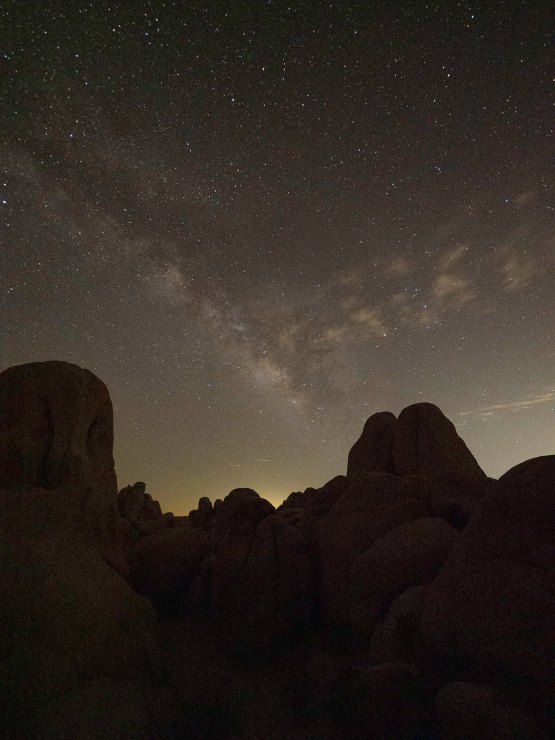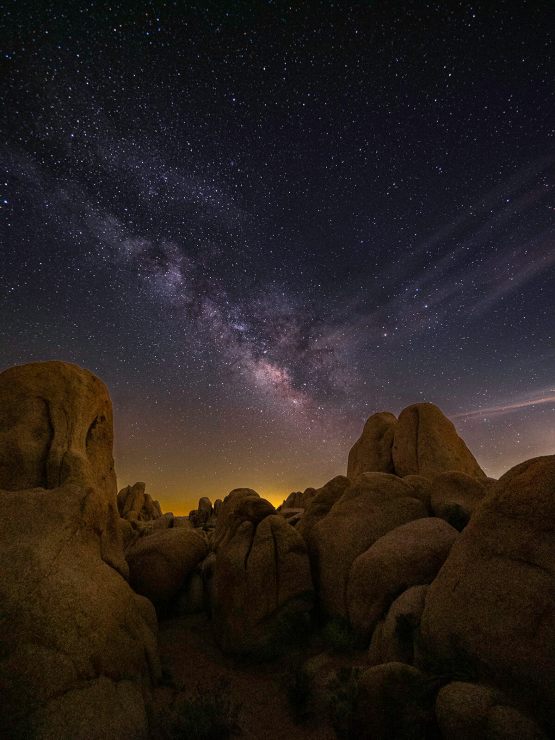The PhotoPills app is a bit of magic when it comes to planning a shoot for the Milky Way. That, combined with tools from Platypod, were helpful in getting my camera in place for a solid composition, and achieving this shot. Platypod tools were helpful in getting my camera in place for a solid composition. As a Platypod ambassador, I get to test out the new builds and find different ways to use them.
Joshua Tree National Park
I had the opportunity to head to Joshua Tree National Park and enjoy the relatively dark skies while chasing the Milky Way. After scouting out the location where I wanted to shoot, I found the Milky Way wouldn’t be in place among the otherworldly rock formations until between 2:45 a.m. and 3:30 a.m. for the composition needed. I went back to bed to grab a few ZZZ’s in the Toyota RAV4 that I have outfitted for boondocking.
Platypod
I used the new Platypod eXtreme base, which allowed me to make my camera position exactly where I wanted and deploy it quickly. The large rock would have hindered that placement if I was using a full sized tripod.
That’s part of the beauty of the Platypod — you can sneak the camera into position and still have complete control of your camera angle and level. The Platyball Elite, when locked into position, remains exactly where I want it with NO camera creep and includes its own level.

The Milky Way
I used the PhotoPills app to plan the time and where the Milky Way would appear in the scene. It is so accurate that when I woke up and looked at the Milky Way position in my head, I said it’s 3:15 a.m. But I was wrong — it was 3:16 a.m. Pretty amazing technology!
My exposure was made with the Olympus OM-D E-M1 Mark III with an Olympus M.Zukio 7-14mm f/2.8 lens at 7mm. Faster glass with a wider aperture is better for capturing the night skies, but if your skies are dark enough Milky Way images can be captured with kit lenses as well.

The sky exposure was eight seconds at f/2.8 at ISO 8000. To get more color and light detail, I made the same exposure eight times and blended them together with Starry Landscape Stacker. This has the net effect of gathering more starlight as if there was a longer exposure.
If you try to get that with a longer exposure alone, the stars will trail and the Galactic Center of the Milky Way will become a big blur.
The foreground was exposed for 40 seconds, processed separately then blended with the Starry Landscape Stacker sky in Photoshop.
.mgl-masonry { display: none; } #mgl-gallery-634ec1bce8dae { column-count: 2; margin: -2.5px; } #mgl-gallery-634ec1bce8dae .mgl-item { padding: 2.5px; } #mgl-gallery-634ec1bce8dae figcaption { padding: 2.5px; } @media screen and (max-width: 800px) { #mgl-gallery-634ec1bce8dae { column-count: 2; } } @media screen and (max-width: 600px) { #mgl-gallery-634ec1bce8dae { column-count: 1; } }
Single image capture before processing.
Made from 8 light frames by Starry Landscape Stacker 1.8.0. Algorithm: Mean Min Hor Noise.
Starry Landscape Stacker is for Mac machines. If you are PC, the program for you is Sequator.
Yours in Creative Photography, Bob
Tell your story with the second annual Visual Storytelling Conference!
Experience four days of interactive, online training sessions featuring a range of educational content with experienced photographers and content creators. This free event kicks off with a series of technical boot camps to build essential skills, followed by live, online sessions on photography, video, business and social media. Join live from March 10-13, 2022!
